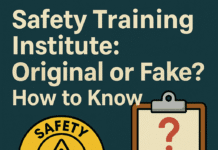
Safety Courses to Become Safety Engineer 2024
In the dynamic landscape of the professional world, the role of safety engineers has become increasingly vital. As industries evolve and technologies advance, the need for professionals who can ensure the safety of workplaces and processes has never been more critical. To step into this challenging yet rewarding career path, individuals often turn to safety courses. Let’s delve into the world of safety courses and explore the journey to becoming a proficient safety engineer in 2024.
Introduction
In the grand scheme of occupational safety, safety engineers play a pivotal role. They are the guardians of workplace well-being, ensuring that employees can carry out their tasks in environments free from unnecessary risks. As the demand for safety engineers continues to grow, the significance of acquiring a solid education in safety courses becomes apparent.
The Evolution of Safety Courses
Historical Context of Safety Courses
Safety courses have a rich history, evolving alongside industrial advancements. From rudimentary safety guidelines to comprehensive educational programs, the journey has been transformative. Early safety courses were often reactive, addressing issues after incidents occurred. However, modern safety courses have shifted focus to proactive measures, emphasizing prevention and risk mitigation.
Advances in Safety Education
With the advent of technology, safety education has undergone significant advancements. Interactive simulations, virtual reality training, and real-life case studies have become integral parts of safety courses. These innovations ensure that aspiring safety engineers are equipped with practical skills and can handle complex scenarios in the field.
Key Components of Modern Safety Courses
Core Subjects Covered in Safety Courses
Modern safety courses cover a wide range of subjects, including risk assessment, hazard identification, emergency response planning, and regulatory compliance. These core subjects provide a comprehensive understanding of the multifaceted nature of safety engineering.
Practical Training and Simulations
Theoretical knowledge alone is insufficient in the realm of safety engineering. Practical training, often facilitated through hands-on experiences and realistic simulations, allows students to apply their learning in controlled environments. This practical exposure is invaluable in preparing safety engineers for the challenges they may face in their careers.
Technological Integration in Safety Education
Embracing technology is a hallmark of contemporary safety courses. From leveraging data analytics to incorporating artificial intelligence in risk analysis, technology plays a crucial role in shaping the modern safety engineer. Graduates are not only well-versed in traditional safety practices but are also adept at utilizing cutting-edge tools to enhance workplace safety.
Benefits of Pursuing Safety Courses
Career Prospects for Safety Engineers
A key motivation for individuals to enroll in safety courses is the promising career prospects. Safety engineers are in high demand across industries such as manufacturing, construction, healthcare, and more. The skill set acquired through comprehensive safety courses positions graduates for success in a variety of professional settings.
Importance of Certification in the Field
While knowledge is essential, certification adds a layer of credibility to a safety engineer’s profile. Many employers prioritize certified professionals when making hiring decisions. Safety courses often conclude with certification exams, providing graduates with a tangible testament to their proficiency in the field.
Choosing the Right Safety Course
Factors to Consider When Selecting a Safety Course
Selecting the right safety course is a critical decision. Factors such as accreditation, curriculum relevance, faculty expertise, and industry partnerships should be carefully considered. Prospective students should assess how well a course aligns with their career goals and the specific areas of safety engineering they wish to specialize in.
Accreditation and Industry Recognition
Opting for courses accredited by reputable organizations ensures that the education received is of high quality and industry-approved. Industry recognition of the course and its certification can significantly impact job opportunities and career advancement for graduates.
Real-life Success Stories
Profiles of Successful Safety Engineers
Real-life success stories serve as inspiration for those considering safety courses. Individuals who started their journey with the foundational knowledge gained from safety courses have gone on to make substantial contributions in their respective fields. These success stories highlight the transformative impact that quality safety education can have on one’s career trajectory.
The Impact of Safety Courses on Their Careers
Successful safety engineers often credit their achievements to the solid foundation laid by their safety education. The ability to apply theoretical knowledge to real-world situations, honed through practical training, has been instrumental in their professional growth.
Challenges and Solutions
Common Challenges Faced by Safety Engineering Students
Despite the benefits of safety courses, students may encounter challenges along the way. Balancing coursework, practical training, and personal commitments can be demanding. Additionally, the complexity of safety engineering concepts may pose a hurdle for some. Acknowledging these challenges is the first step in finding effective solutions.
Strategies to Overcome Obstacles
To overcome challenges, students can leverage support systems, such as peer groups, mentorship programs, and academic resources. Establishing a balance between theoretical learning and practical application is crucial. Institutions offering safety courses can also play a role by providing robust support structures to help students navigate their educational journey successfully.
Industry Trends in 2024
Emerging Technologies in Safety Engineering
The landscape of safety engineering is continuously evolving, driven by technological advancements. In 2024, emerging technologies such as Internet of Things (IoT), artificial intelligence, and predictive analytics are expected to play a significant role in enhancing safety measures. Safety courses are adapting to incorporate these trends, ensuring that graduates are well-prepared for the future of the industry.
Adaptation of Safety Courses to Current Industry Needs
To stay relevant, safety courses must align with current industry needs. This includes updating curricula to cover emerging risks, incorporating the latest regulatory changes, and integrating technology-driven solutions. Institutions offering safety courses should maintain close ties with industry leaders to ensure their programs stay ahead of the curve.
Tips for Excelling in Safety Courses
Study Strategies for Safety Engineering Students
Success in safety courses requires a strategic approach to studying. Creating a study schedule, actively participating in discussions, and seeking clarification on complex topics are effective strategies. Collaborating with peers for group study sessions and engaging with practical exercises can enhance understanding and retention.
Networking Opportunities and Mentorship
Building a professional network during safety courses can open doors to future opportunities. Networking events, industry conferences, and mentorship programs provide valuable connections that can support career growth. Aspiring safety engineers should actively seek out these opportunities to broaden their horizons.
The Future of Safety Engineering
Predictions for the Future of the Safety Engineering Profession
The future of safety engineering holds exciting possibilities. With the integration of advanced technologies, safety engineers are expected to play a more proactive role in risk prevention. Lifelong learning and continuous improvement will be crucial for professionals to stay abreast of industry developments and emerging challenges.
Lifelong Learning and Continuous Improvement in the Field
The dynamic nature of safety engineering necessitates a commitment to lifelong learning. Professionals should embrace opportunities for continuing education, attend workshops, and stay informed about the latest trends. This proactive approach ensures that safety engineers remain at the forefront of their field throughout their careers.
Testimonials from Safety Course Graduates
Personal Experiences and Insights from Recent Graduates
Graduates of safety courses often have valuable insights to share. Their personal experiences, challenges faced, and how the courses influenced their careers provide prospective students with a glimpse into the real-world impact of safety education. These testimonials offer a candid perspective on the transformative journey from student to successful safety engineer.
How Safety Courses Impacted Their Career Trajectories
Graduates frequently attribute their career success to the skills and knowledge acquired during safety courses. From landing coveted positions to effectively handling on-the-job challenges, the impact of safety education echoes throughout their professional lives.
Comparison of Different Safety Courses
Overview of Popular Safety Courses
An overview of popular safety courses helps prospective students make informed decisions. Comparing factors such as curriculum structure, duration, and specializations offered can guide individuals in selecting the course that best aligns with their goals. This comparative analysis ensures that students invest their time and resources wisely.
Comparative Analysis of Course Structures and Offerings
Delving deeper into the specifics of course structures and offerings allows for a more nuanced understanding. Examining the balance between theory and practical application, the inclusion of industry-relevant topics, and the availability of resources for hands-on training are crucial aspects to consider.
Addressing Common Misconceptions
Dispelling Myths About Safety Courses
Misconceptions about safety courses may deter potential students. Addressing common myths, such as the perception that safety courses are overly theoretical or limited in scope, helps set realistic expectations. Clearing up misunderstandings fosters a more accurate understanding of the value and practicality of safety education.
Clarifying the Expectations and Realities of Safety Engineering
Ensuring that aspiring safety engineers understand the expectations and realities of the profession is vital. Safety courses not only provide theoretical knowledge but also equip students with practical skills and a problem-solving mindset. Clarifying these aspects helps individuals make informed decisions about pursuing a career in safety engineering.
Industry Support and Recognition
Collaboration Between Educational Institutions and Industry Leaders
The collaboration between educational institutions and industry leaders is instrumental in shaping effective safety courses. Industry insights guide the development of curricula, ensuring that graduates are well-prepared for the challenges of the workplace. Strong ties between academia and industry foster a symbiotic relationship that benefits both students and employers.
The Importance of Industry Support for Safety Courses
Industry support for safety courses goes beyond collaboration; it also extends to job placement and recognition of certifications. Institutions with strong industry connections can facilitate internships, co-op programs, and employment opportunities for their students. This support enhances the credibility and relevance of safety courses in the eyes of employers.
To become a Safety Engineer in 2024, you'll need to pursue relevant education and training in safety-related disciplines. Here's a suggested list of safety courses that can help you build the necessary skills and knowledge:- Bachelor’s Degree in Safety Engineering or Related Field:
- Pursue a bachelor’s degree in safety engineering, occupational health and safety, or a related field. This provides the foundational knowledge required for a career in safety engineering.
- Occupational Safety and Health Administration (OSHA) Courses:
- OSHA offers various training courses that cover occupational safety and health standards. Consider courses such as OSHA 30-hour General Industry or OSHA 30-hour Construction Industry.
- Process Safety Management (PSM) Training:
- PSM is crucial in industries such as chemical, petrochemical, and manufacturing. Training programs focusing on PSM will help you understand and manage potential risks in industrial processes.
- Environmental Health and Safety (EHS) Courses:
- Explore courses in environmental health and safety to gain a comprehensive understanding of how safety practices align with environmental considerations.
- Certified Safety Professional (CSP) Exam Preparation:
- Consider enrolling in courses that specifically prepare you for the CSP exam. Achieving the CSP certification can enhance your credibility and job prospects.
- Industrial Hygiene Courses:
- Learn about industrial hygiene principles, including exposure assessment, hazard communication, and control measures to protect workers from workplace hazards.
- Risk Assessment and Management Courses:
- Understanding risk is a fundamental aspect of safety engineering. Courses in risk assessment and management will equip you with the skills to identify, analyze, and mitigate risks.
- Fire Safety and Emergency Response Training:
- Gain knowledge in fire safety, emergency response, and evacuation procedures. Courses in these areas are essential for ensuring workplace safety.
- Construction Safety Courses:
- If you plan to work in the construction industry, consider courses that focus on construction safety standards and practices.
- Professional Development Workshops and Seminars:
- Attend workshops and seminars to stay updated on the latest advancements in safety engineering, regulations, and technologies.
- Advanced Degrees (Optional):
- Pursuing a master’s degree in safety engineering or a related field can provide advanced knowledge and open up opportunities for leadership roles.
Remember to check with relevant professional organizations and certification bodies for the most up-to-date requirements and recommendations in the field of safety engineering. Additionally, gaining practical experience through internships or entry-level positions can significantly enhance your skills and employability.Conclusion
In conclusion, the journey from aspiring professional to successful safety engineer is paved with the knowledge and skills gained through quality safety courses. The evolving landscape of safety engineering demands continuous learning, adaptability to technological advancements, and a proactive approach to risk prevention. Aspiring safety engineers are encouraged to embrace the opportunities presented by safety courses, leveraging them as stepping stones to a fulfilling and impactful career.
OSHA Safety Officer Certification
NEBOSH Safety Manager Requirements
IOSH Safety Manager Requirements
OSHA Safety Manager Requirements
NEBOSH Safety Engineer Requirements
Frequently Asked Questions (FAQs)
- What are the prerequisites for enrolling in a safety course to become a safety engineer?Prospective safety engineering students typically need a high school diploma or equivalent. Some courses may have additional requirements, so it’s advisable to check the specific prerequisites of the chosen program.
- How long does it take to complete a safety course, and are there part-time options available?The duration of safety courses varies, but many can be completed within one to two years. Part-time options are often available, allowing individuals to balance their studies with other commitments.
- Is certification essential for a career in safety engineering?While certification is not mandatory, it enhances one’s credentials and is often preferred by employers. Many safety courses conclude with certification exams, providing graduates with a competitive edge in the job market.
- How can safety engineering students stay updated with industry developments after completing their courses?Lifelong learning is crucial. Graduates can attend workshops, join professional organizations, and participate in industry conferences to stay informed about the latest advancements and best practices in safety engineering.






















Learn about industrial hygiene principles including exposure assessment